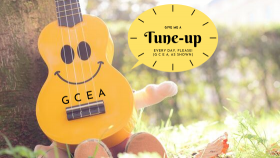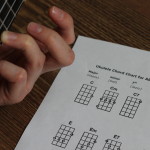How to tune your ukulele: Grab a clip-on ukulele tuner for ease!
What notes do I tune my ukulele to?
All ukuleles (except for baritones) strings are tuned to the notes (from nose to knees) G, C, E, A. If you play piano, C = middle C, and the others are the ones above middle C in that octave. If that makes no sense, the C note is the lowest. This will feel odd if you’ve not heard it before, as we grow up listening to the guitar, and the guitar strings (from knees to nose) get lower in pitch. Not so with the ukulele, which has what’s known as ‘re-entrant tuning’. Played ‘open’ (that means not pressing your fingers down on any strings) and strumming, these notes make either the chord of C6 or Am7.
Re-entrant tuning:
Standard ukulele tuning is known as ‘re-entrant tuning’, which means it re-enters the scale again on the G-string (da dum tss), so doesn’t move lower in pitch from knees to nose. This is true for different sizes of ukulele including (smallest to the largest size, more on size later) sopranino, soprano, concert, and tenor ukuleles, which are all tuned in this way using these notes.
Tuning your ukulele using a tuning device:
If you’re new to music, you’ll probably need assistance. In short, it works better in noisy environments and tends to be more accurate. I recommend you get a clip-on ukulele tuner. I mean, you can get a free app on your phone to help you to find which note each string is tuned to, but they aren’t great if you’re in a noisy environment or with other ukulele players. The ukulele is a very social instrument, so I recommend you get a clip-on ukulele tuner. It works by detecting the frequency of vibrations of your ukulele to tell you which note it is and is usually accurate, so long as the batteries are charged.
If you don’t (yet) have a clip-on ukulele tuner, grab one from here, the Amazon Affiliates shopfront, with lots of other ukuleles and accessories to choose from. In the interests of transparency, we are part of the amazon referral scheme so if hundreds or thousands of you buy based on links you clicked via us, we may make a few pence. In the unlikely event that millions of you click, we may make a few pounds. If you’ve found this information useful, please share it around liberally, as we like the idea of this unlikely instance.
Here’s a cringey old video of me, to help you to use it for the first time:
Other tuning options:
Historically, for sopranino, soprano, concert, and tenor ukuleles, there is an alternative traditional English tuning – to the notes A, D F#, B. When played open, this gives the chords of either D6 or Bm7.
Baritone ukuleles are tuned to D, G, B, and E. Bass ukuleles are tuned to E, A, D, and G.
For all stringed instruments, there are endless options of tunings, not only the notes themselves but also the frequency (more on that later). You can tune up how you like, but each time you change the tuning, the chord shapes can be different, and it might be trickier to find music that has the correct chord shapes to play along harmoniously with other people.
Tuning your ukulele by ear:
If you’re musically trained, or find it easy to pitch match, you might want to tune up by ear.
If you’ve enjoyed this, here are some more posts of ours that might help:
Have you already got your ukulele, here are some recommendations, here.
How to play the G chord, here.
See how to play the Bb chord on the ukulele, here.
How to play the E chord, on the ukulele here.
Get a free ukulele chord chart (and help with how to read it) from here.
Do you want 6 basic strum patterns to get you going? See more here.
If you’re in London, UK, you’ll learn this in our courses. Book your course to join us in London.
If you’re not, please support us on Patreon so you can get access to all our upcoming online tutorials and challenges.
*in the interests of transparency, we are part of the amazon referral scheme so if hundreds or thousands of you buy based on links you clicked via us, we may make a few pence. In the unlikely event that millions of you click, we may make a few pounds. If you’ve found this information useful, please share it around liberally, as we like the idea of this unlikely instance.
Updated on 25/9/2019.




Leave a Reply
Want to join the discussion?Feel free to contribute!